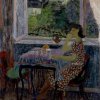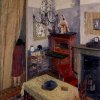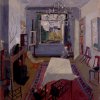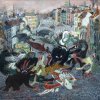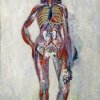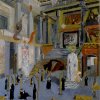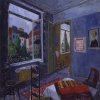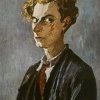In 1941, the Youth Art (Art Jeune) exhibition at the Atrium Gallery in Brussels highlights Louis Van Lint, who won with this occasion a Prize awarded by the newspaper Le Soir. The same year, in the difficult context of the occupation, Louis Van Lint, Gaston Bertrand and Anne Bonnet succeed to set up an exhibition of young Belgian artists at the Fine Arts Palace in Brussels, called Contribution 41 (Apport 41). The following year, Louis Van Lint participates alone (his first personal exhibition), while Robert Delevoy, who opened his Apollo Gallery, takes over and organizes the version of 42 of the exhibition Contribution (Apport). Because of the intimist works painted by Van Lint up until that time (interiors, portraits, urban views), the art historian Paul Haesaerts mentions him in a book grouping a series of Belgian artists born at the beginning of the century, that he names The Animism. Back to human. In 1943, however, some new works by the artist demonstrate a spirit well opposed to this Animism. There was a clap of thunder, in effect, during the art show Contribution 43 (Apport 43) when Van Lint exposes The Flayed Body (L'Ecorché), a canvas with acid tones and a style showing a human figure exhibiting without modesty nerves and viscera, and which he subtitled, as an anti-animist pamphlet, Back to Human (Retour à l'humain). This major work is part of the Thomas Neyrinck collection, administered by the King Baudouin Foundation.

A feverish atmosphere and a sense of revolt are displayed by a few other works of this year, as The Self-portrait with a Red Tie (Autoportrait au col ouvert ou à la cravatte rouge), The Millenary Polar Star (La Tramontane Millénaire), or The Law : the scales of justice are flawed (Le Droit se balance ou la Justice bafouée), a painting of a quasi boschian verve in which one can see in a theatrical courthouse a series of judges and lawyers forced to the gallows among sculpted allegories covered by ensorien masks. 1943 is also the year when the artist wins in Brussels the Popular Art Prize (Prix de l'Art Populaire). His work raises interest among critics and his first art collectors.




